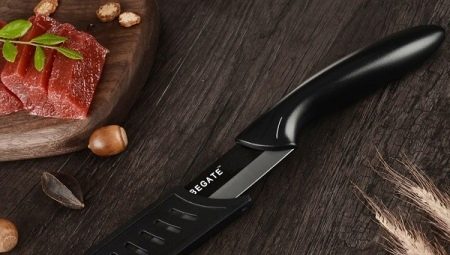Sooner or later, every owner or hostess has the question of acquiring such an important kitchen appliance as a knife. It is important to make the right choice - after all, the device must be sharp and comfortable, but most of them become unusable very quickly.
Many people are now leaning in favor of ceramic knives - they are sharp, it’s practically not necessary to sharpen them, moreover, they are also environmentally friendly. Nevertheless, some disagree with this, from which numerous disputes arise. It is about ceramic knives, their pros and cons that will be discussed in the article.
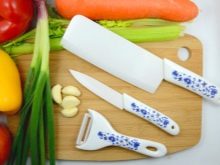
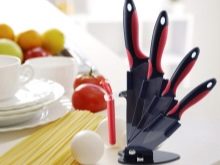

Origin
Ceramic knives were first created in Japan, but it is worth noting that much earlier Soviet scientists guessed this idea when they began to replace ordinary metal blades with ceramic ones. The invention was ignored, therefore, Japan is considered its homeland.
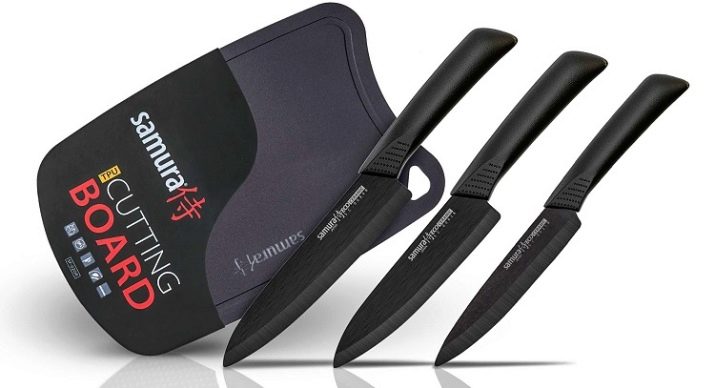
For a long time, only professional sushi chefs used this device, and for good reason - the products cut with such a knife and the dishes prepared with it had no metallic taste. This device went on sale recently.
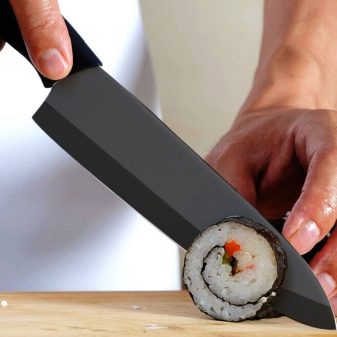
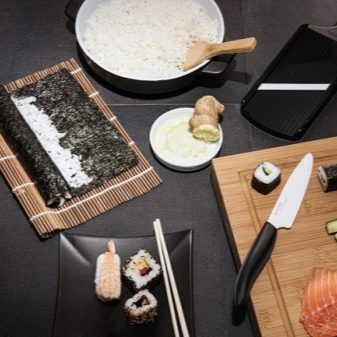
Production
In general, all appliances made using ceramics are considered high-tech. It is worth noting that the name "ceramic" is not a type of metal or material from which the product is made, but the manufacturing method itself.
This happens with the help of agglomeration and firing. If we talk about the composition of the blade, then most of it is zirconium dioxide. It is sharpened manually at an obtuse angle and from a rather thick plate, which is extremely difficult. The result is a reliable and fairly sharp device.Hence the high price. The average blade length is 15-16 centimeters, and its coating is usually titanium.
Using a ceramic knife is very convenient. The handle is often made of plastic and has the right practical shape, thanks to which it fits perfectly in the hand.
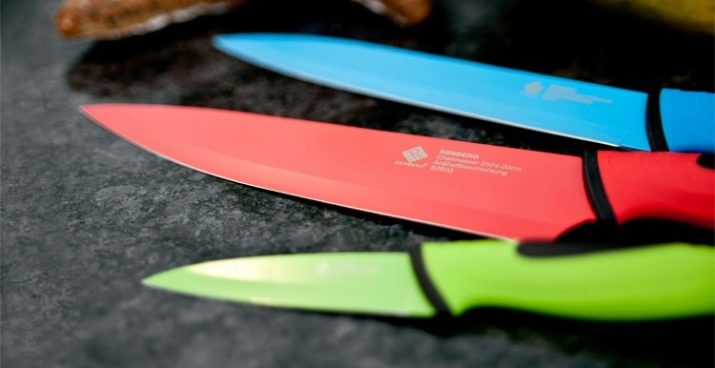
pros
It's time to deal with the main advantages and disadvantages of this device. It’s worth starting, of course, with the pros.
- Eco-friendly knife. Due to its chemical indifference, it does not absorb unpleasant odors at all, and also does not destroy the vitamins contained in the products. This fact is a definite plus for mothers with young children, as well as for cooks who care about the clean composition of the dish.
- Ceramic knife Perfect for slicing fresh vegetables and fruits.
- Sharp blade. One of the main advantages is the sharpness of the blade and the fact that with careful care it will not be necessary to sharpen it for quite a long time.
- Quality cutting. Skillfully made blade allows you to thinly cut absolutely any product, be it meat or vegetables. The cutting process itself does not cause difficulties; all products are cut easily and quickly.
- Little weight. The extremely light weight of the device allows you to use the cutting technique "on their own" without much effort.
- Resists corrosion. A ceramic knife will never, under any circumstances, be covered with rust, in addition, it is able to maintain its original appearance for a long time and not tarnish.
- Convenient handle. The handle of such a knife can be either folding or ordinary. It is extremely convenient to hold it due to its optimal shape.
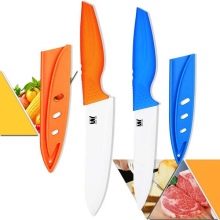

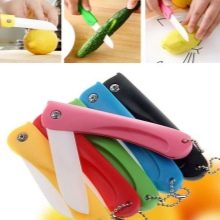
Minuses
Despite the huge number of advantages, when choosing a kitchen knife should take into account all sorts of disadvantages, which are also many.
- Low strength. Even though ceramics are clearly harder than metal, their knives do not differ in strength in structure. Having stumbled upon cutting a solid object, the device can easily crack, which is a significant drawback.
- In addition, there are often cases when the knife breaks even when falling on the carpet or when stored with other kitchen appliances. The same applies to impacts on the side surface of the knife. In no case should the blade be bent, as this can lead to unusability. Such fragility is associated directly with the length of the blade - because the longer it is, the more fragile.
- Dependence on sudden temperature changes. A rapid increase or decrease in temperature also leads to splits of the device.
- Despite the fact that this knife is able to cut almost everything, cutting them too hard products is highly undesirable. For such purposes, it is best to use classic metal knives.
- Sharpening. Despite the fact that the need for sharpening a knife like a ceramic one is extremely rare, it is still necessary. It is very difficult to carry out this process, since it has many nuances and rules.
- High price. As mentioned earlier - the blades for these knives are made manually and using special equipment, so the price of a high-quality device starts from 2000 rubles or more.
Almost all the disadvantages of a ceramic knife are associated only with its low strength, therefore, when using it, all operating rules should be faithfully followed and stored in a proper place. It is extremely difficult to repair a broken device, and it’s also not cheap.
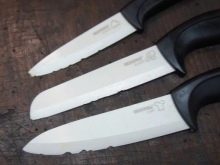
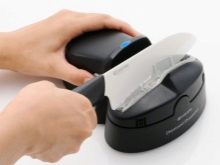

What can be cut?
Ideal options for slicing with such a knife are soft foods, such as bread, vegetables, fruits, cooked sausages, soft cheese and so on. A ceramic knife is not suitable for cutting hard or frozen foods. In addition to cutting food products, such a knife can also be used to peel vegetables or fruits.
For long-term and high-quality operation, it is necessary to adhere to simple rules.
- Never cut solid foods.This procedure will inevitably lead to a split blade.
- It is recommended to use wood or plastic planks as a cutting board. Glass and ceramic boards should be forgotten.
- All movements during the cutting process should be smooth and soft. Products such as greens should not be chopped, but carefully cut.
- In no case should you clean the cutting boards with a ceramic knife, or beat anything with it.
- Avoid washing in the dishwasher, as well as with detergents, replacing them with soft non-abrasive substances.
- One of the most important rules for the operation of the knife is its proper storage. It is very important to keep it separate from other kitchen and cutlery, otherwise the blade will gradually begin to crumble.
- When working with a knife, it is recommended to avoid sudden increases or decreases in temperature.
- Hold the ceramic knife tightly, without dropping it or bumping into foreign objects.
Many of the above rules scare and even lead to shock, but given the quality of the device and its environmental friendliness, you can safely get used to such conditions.
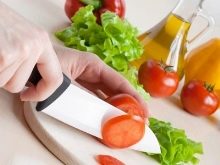
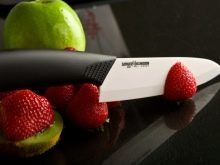
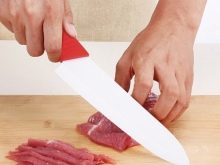
How to sharpen at home?
Over time, even such a wonderful knife, like a ceramic one, becomes dull. However, throwing a dull knife is not worth it - you can sharpen it yourself again. In order to sharpen a ceramic knife at home, you should be guided by several rules.
- The first thing you should know before you get down to business - household tools used to grind ordinary metal knives will not work. Such devices will not only not help to make the knife sharper, but also spoil it.
- It is better to take care of a specialized tool right away - directly when buying a knife. In stores you can find not only mechanical, but also electrical appliances suitable specifically for ceramic products.
- When sharpening a kitchen appliance, it is important to be confident in your abilities and skills so as not to damage the knife. Otherwise, it is best to consult a specialist.
- It is also important to know that the sharpening of a ceramic knife must be one-sided. That is, the side that acts as a wedge is processed first, and the burrs that appear are removed. In the case when there are two such parties, the work must be carried out alternately, creating perfect symmetry.
So, having studied the above nuances, you can safely get to work. There are several options for sharpening ceramic knives.

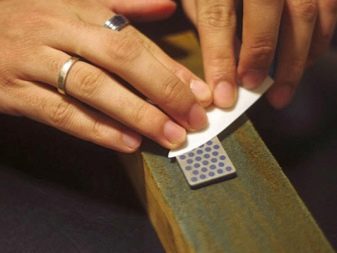
Using a diamond bar or paste
This method is considered one of the easiest and most common. It consists in the fact that the prepared diamond bar is immersed in cold water for 20-30 minutes. Further, at a strictly defined angle and with a certain trajectory of movements, sharpening occurs separately on each side.
Diamond paste is considered to be an excellent analogue of the bar - a rather effective method, but it is more suitable not for sharpening, but for easy updating of the blade. The cutting surface is completely cleaned, then diamond paste is applied on it, after which the device is polished using a wooden base.
It is very important to maintain the same angle of inclination.


Using garbage
Just like diamond paste, musat should only be used in cases where the edges need to be slightly sharpened. The musat itself is a solid rod mounted on a horizontal surface. By mechanical actions, it can be compared with an ordinary file - the device smoothly runs along the edges of the blade, gradually sharpening it.
This device must be kept upright, and the blade should be sharpened without strong pressure so as not to cause the ceramic to split.
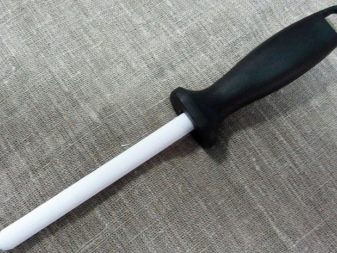

Mechanical and electrical appliances
The basic and most simple to use “sharpeners” for ceramic knives are mechanical or electrical devices.These options are applied only in the most advanced cases - when serious processing is required. However, even here there is an important nuance - you need to choose a device strictly based on the type of knife. When sharpening a single-sided blade with a double-sided device, you can only spoil it to the end.
If we talk about the electric machine, it is usually a diamond wheel. It is necessary to use two circles of different grain sizes: hard for grinding, and softer for grinding.
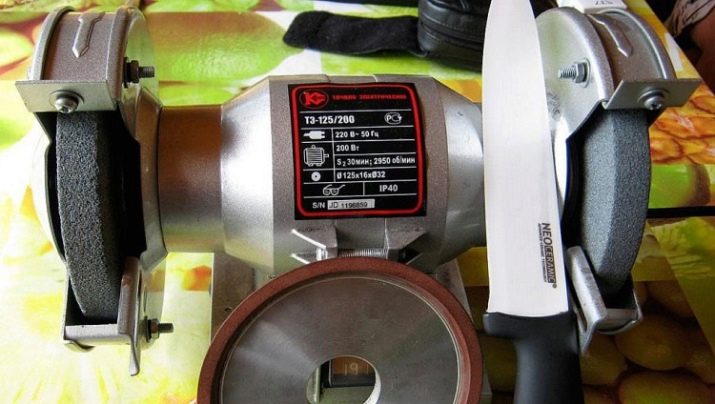
Real professionals adhere to certain rules.
- The lower the machine speed - the more accurate the work will be.
- You need to grind the ceramic blade away from the handle, gradually approaching its end.
- An angle of 15 degrees is required to create a very sharp blade. However, it is worth considering the fact that a device sharpened at such a small angle will blunt much faster. It is best to observe an angle of 30 degrees.
- A sign of quality and correctly performed work is considered to be a slight bulge on the blade immediately after work.
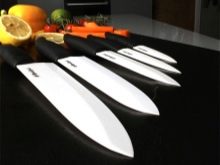
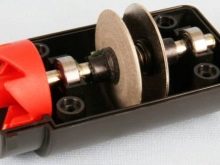
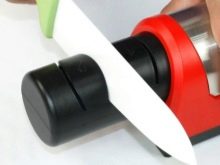
As for mechanical files, there are quite a lot of different variations that work on the same principle. However, it is best to choose one that does not cause rapid fatigue in the muscles. Such a device does the job much slower than others, but at the same time creates better blades.
Despite all the above methods, many people tend to believe that it is impossible to make a ceramic blade as sharp as before.
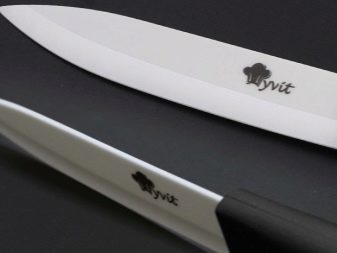

How to choose?
Choosing a knife from ceramics is not such a difficult task, it is only important to understand what purpose it will be needed for. Making a choice is necessary based on a number of principles.
- The first thing you should pay attention to is the handle of the knife. For fake specimens, the handle is simply attached to the blade, while for the originals, it is literally welded.
- Another important factor is color. For real Japanese blades, the blade has a pure white color, while for fakes it has a yellowish tint.
- When buying it will be useful to hold a knife - test it in your hand. The handle should be as comfortable as possible and not slip out of the palm of your hand.
- Since ceramic knives are distinguished by their extraordinary sharpness, it is necessary to try it out by cutting a sheet of paper or any other paper object. The paper under such a blade should be cut extremely lightly and effortlessly.
- Experts recommend stopping the choice with knives with a blade of no more than 20 centimeters. As already mentioned, a device that is too long breaks and breaks much more easily than average ones.
- Another important detail is the color of the handle of the knife. There are only two of them: black and white.
- Black ceramic knives are considered more durable - they are used by real chefs. Such a product is somewhat more expensive than white, but its quality is better. Often on sale you can find a whole set - it has both black and white knives with covers.
- As for the company, it is best to choose Japanese-made knives, namely: Samura or Kyocera. Such brands as Boker, Mallony, EcoCeramic and others are also considered good.
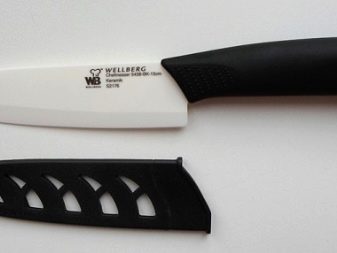

Customer reviews
In general, most reviews of ceramic knives can be considered positive. Quality corresponds to its price - the product is quite sharp, and what is important in the modern world - environmentally friendly, does not leave a smack of metal in the products. However, there are also negative reviews related only to the strength of the ceramic knife. It breaks easily, but with proper handling, this can be prevented.
In addition to fragility, people are often repelled by the rules of operation of this product, but over time it is quite possible to get used to it. Ceramic knife is a truly unique kitchen appliance, which is preferred by the best chefs.
Having given a considerable amount of money, you can get a quality and convenient product that can create amazing dishes.

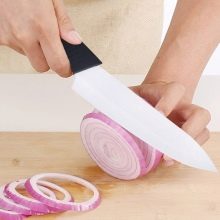

In the next video you will find an overview of Samura ceramic knives.
